To start the launch off I had the chance to check out the Sapphire RX 7700 XT Pulse which is their budget-focused card and a stock-clocked card. I also took a look at the overclocked XFX QICK 319 RX 7700 XT Black. Well, now I’ve got the Sapphire RX 7700 XT PURE which sits in between Sapphire’s Pulse and Nitro+ lineups. It is an overclocked card and it also improves on the Pulse with a third fan and a larger cooler but most exciting is this is a white color scheme card from Sapphire. They did bring out the RX 6950 XT PURE which was partially white but still had black fans. White cases and white builds have been popular for a long time now, it is exciting to see Sapphire finally jumping in with their own option. So I’m going to check out what the RX 7700 XT PURE is all about, put it to the test in our test suite, and then we can see how it fits in the market!
Product Name: Sapphire RX 7700 XT PURE
Review Sample Provided by: Sapphire
Written by: Wes Compton
Amazon Affiliate Link: HERE
AMDs new RX 7700 XT and 7800 XT
At Gamescom this year AMD announced two new GPUs to fill in a few big gaps in their current 7000 Series GPU lineup. Before the announcement, they had the RX 7600, RX 7900 XT, and RX 7900 XTX. That covered the higher end of the market with their 4K focused cards and the 7600 which is a mid-range 1080p focused card. The two new models fit in the middle with a 1440p resolution focus. While 1080p is still the most widely used resolution on Steam hardware surveys, the 1440p resolution is growing quickly, AMD highlighted this in the presentation pointing out a 44% growth year on year on the Steam hardware survey.
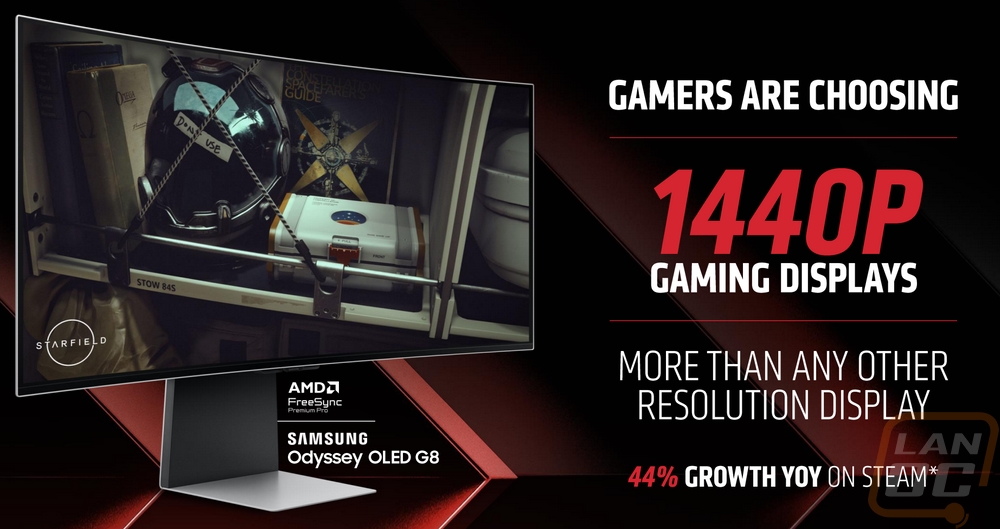
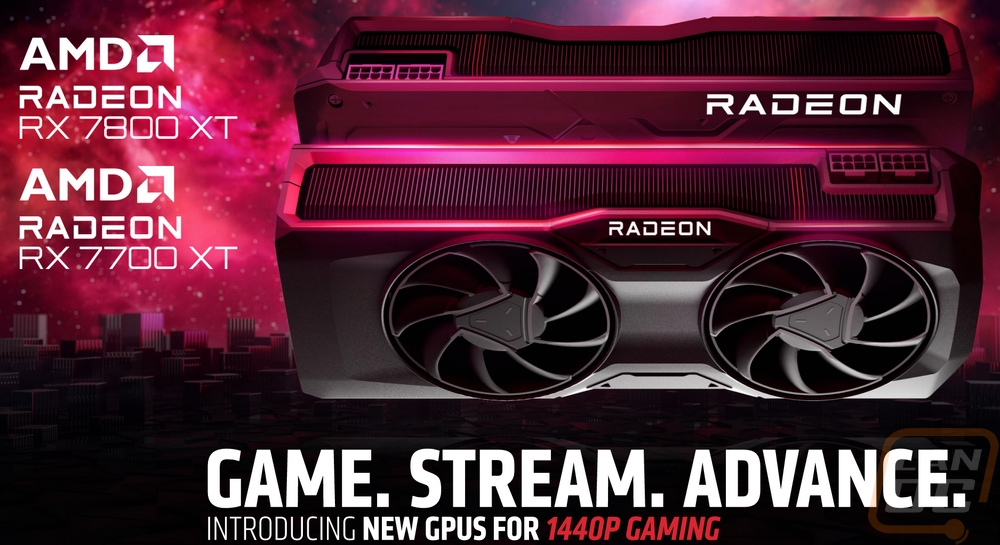
To get a look at where the new RX 7700 XT and RX 7800 XT sit spec wise I have the specs from the AMD briefing as well as a full breakdown that includes the RX 7600 and RX 7900 XT which for the 7000 Series sit above and below the two cards as well as the RX 6700 XT and RX 6800 which are the comparable cards from last generation. Both the 7700 XT and the 7800 XT have the same 5nm and 6nm combination of manufacturing process that the 7900 XT has. The two GPUs have the same die size and transistor count with them sharing the same base GPU but the compute units and the stream processor counts show us that it has been cut down slightly for the 7700 XT compared to the 7800 XT. The 7800 XT is right with the 6800 in stream processors as well as compute units and ray accelerators but last generation's cards didn’t have the AI accelerators which the 7800 XT has 120 and the 7700 XT has 108. The 7800 XT has a slightly lower game GPU clock than the 7700 XT with it at 2124 MHz to 2171 MHz on the 7700 XT. The same goes for the boost clock which the 7800 XT can see up to 2430 MHz whereas the 7700 XT can do up to 2544 MHz. The single precision performance numbers give us an idea of what the lower clock speeds but higher core counts translate to. The 7700 XT can do up to 35 TFLOPS whereas the 7800 XT is slightly higher at 37 TFLOPS. The 7900 XT is way out ahead of that at 51 TFLOPS and the 7600 is well below the two at 21 TFLOPS. Then both the 6700 XT and the 6800 are well below the 7600 at 13.21 TFLOPS and 16.17 TFLOPS.
The 7700 XT has 48 MB of the 2nd generation Infinity Cache whereas the 7800 XT has 64 MB. Then for memory, the 7700 XT has 12GB of GDDR6 memory to the 16GB on the 7800 XT. They also have different memory bus interfaces with a 192-bit interface for the 7700 XT and 256-bit for the 7800 XT and the memory on the 7800 XT is also clocked faster with it running at 19.5 Gbps and 18 Gbps for the 7700 XT. Overall the higher cache and everything else translates to the 7700 XT having an effective memory bandwidth of 1995.3 GB/s to the 2708.4 GB/s for the 7800 XT. Both cards have a traditional PCIe 4.0 x16 interface, not the x8 that the RX 7600 had. Then for power, the two cards do have different total board power ratings with the 7700 XT at 245 watts and the 7800 XT at 263 watts. AMD also announced the base pricing of the cards at Gamescom with the RX 7700 XT at $449 and the RX 7800 XT at $499. The 7800 XT is available in a reference design directly from AMD as well as designs from their partners but the 7700 XT doesn’t have a reference design and will only be available with the partner designs.
|
Specifications |
RX 7600 |
RX 6700 XT |
RX 7700 XT |
RX 6800 |
RX 7800 XT |
RX 7900 XT |
|
Architecture |
RDNA 3 |
RDNA 2 |
RDNA 3 |
RDNA 2 |
RDNA 3 |
RDNA 3 |
|
Manufacturing Process |
6nm |
7nm |
5nm GCD + 6nm MCD |
7nm |
5nm GCD + 6nm MCD |
5nm GCD + 6nm MCD |
|
Transistor Count |
13.3 Billion |
17.2 Billion |
28.1 Billion |
26.8 Billion |
28.1 Billion |
57.7 Billion |
|
Dia Size |
204 mm² |
335 mm² |
200mm² GCD 150mm² MCD |
520 mm² |
200mm² GCD 150mm² MCD |
529 mm² |
|
Compute Units |
32 |
40 |
54 |
60 |
60 |
84 |
|
Ray Accelerators |
32 |
40 |
54 |
60 |
60 |
84 |
|
AI Accelerators |
64 |
-- |
108 |
-- |
120 |
168 |
|
Stream Processors |
2048 |
2560 |
3456 |
3840 |
3840 |
5376 |
|
Game GPU Clock |
2250 MHz |
2424 MHz |
2171 MHZ |
1815 MHZ |
2124 MHz |
2025 MHz |
|
Boost GPU Clock |
Up to 2655 MHz |
Up to 2581 MHz |
Up to 2544 MHz |
Up to 2105 MHz |
Up to 2430 MHz |
Up to 2394 MHz |
|
Peak Single Precision Perf. |
Up to 21 TFLOPS |
Up to 13.21 TFLOPS |
Up to 35 TFLOPS |
Up to 16.17 TFLOPS |
Up to 37 TFLOPS |
Up to 51 TFLOPS |
|
Peak Half Precision Perf. |
Up to 43 TFLOPS |
Up to 26.43 TFLOPS |
Up to 70 TFLOPS |
Up to 32.33 TFLOPS |
Up to 74 TFLOPS |
Up to 103 TFLOPS |
|
Peak Texture Fill-Rate |
Up to 339 GT/s |
Up to 413 GT/s |
Up to 550 GT/s |
Up to 505.2 GT/s |
Up to 583 GT/s |
Up to 804 GT/s |
|
ROPs |
64 |
64 |
96 |
64 |
96 |
192 |
|
Peak Pixel Fill-Rate |
Up to 169 GP/s |
Up to 165.2 GP/s |
Up to 244 GP/s |
Up to 202.1 GP/s |
Up to 233 GP/s |
Up to 459 GP/s |
|
AMD Infinity Cache |
32 MB (2nd Gen) |
96 MB (1st Gen) |
48 MB (2nd Gen) |
128 MB (1st Gen) |
64 MB (2nd Gen) |
80 MB (2nd Gen) |
|
Memory |
8GB GDDR6 |
12GB GDDR6 |
12GB GDDR6 |
16GB GDDR6 |
16GB GDDR6 |
20GB GDDR6 |
|
Memory Speed |
18 Gbps |
16 Gbps |
18 Gbps |
16 Gbps |
19.5 Gbps |
20 Gbps |
|
Effective Memory Bandwidth w/AMD Infinity Cache |
Up to 476.9 GB/s |
Up to 1278.0 GB/s |
Up to 1995.3 GB/s |
Up to 1664.2 GB/s |
Up to 2708.4 GB/s |
Up to 2900 GB/s |
|
Memory Bus Interface |
128-bit |
256*bit |
192-bit |
256-bit |
256-bit |
320-bit |
|
PCIe Interface |
PCIe 4.0 x8 |
PCIe 4.0 x16 |
PCIe 4.0 x16 |
PCIe 4.0 x16 |
PCIe 4.0 x16 |
PCIe 4.0 x16 |
|
Total Board Power |
165W |
230W |
245W |
250W |
263W |
300W |
|
Launch MSRP |
$269 |
$479 |
$449 |
$649 |
$499 |
$899 |
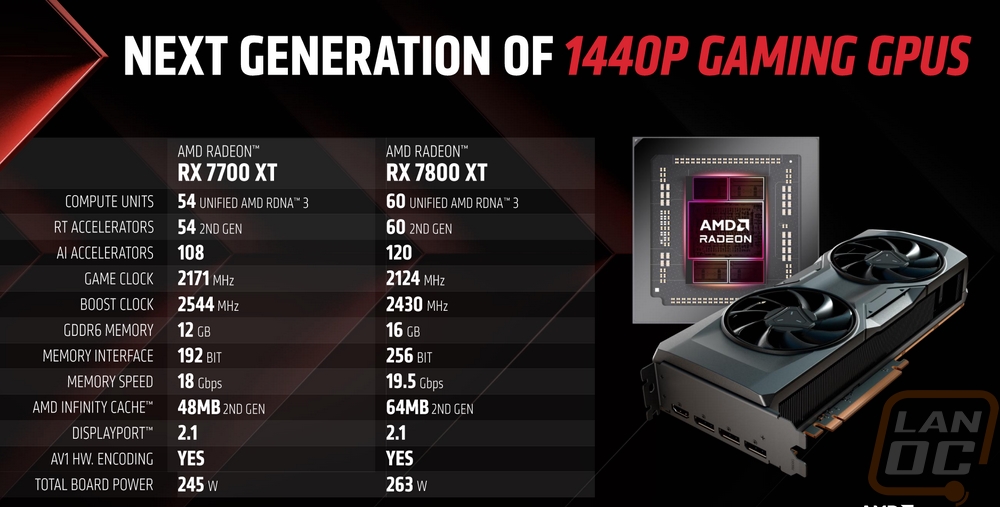
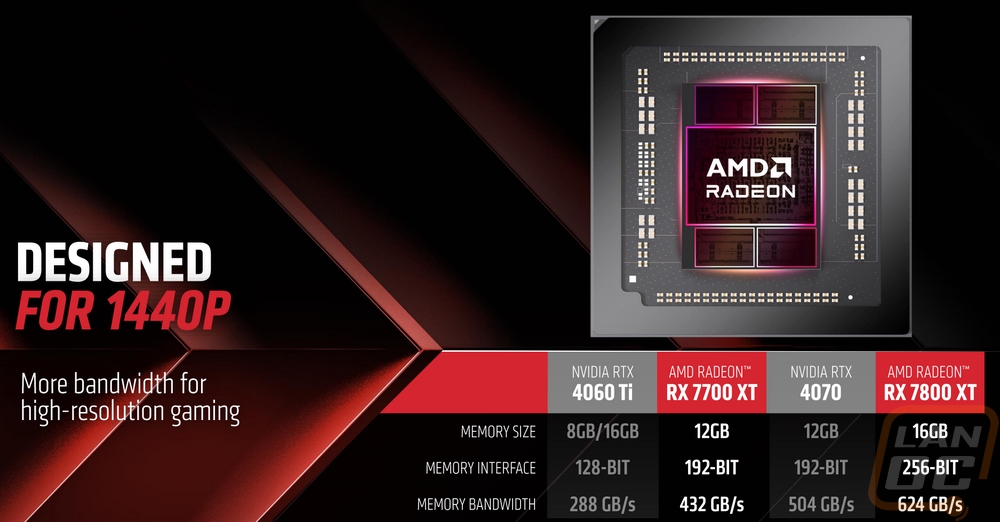

Alongside of the two new cards, AMD also announced their FidelityFX Super Resolution 3 which brings frame generation to AMD cards. Unlike DLSS from Nvidia AMD has this as an open standard so it can not only work with all of AMDs cards, but it can also work with Nvidia cards as well. FSP 3 with upscaling can work with AMD cards back to the RX 590 and Nvidia 10 Series cards but that doesn’t include frame generation. For that, you will need an AMD 5700 or better and RTX 20 Series or higher. They showed off the performance differences that you can see with Forspoken from Square Enix where they were able to go from 36 FPS up to 122 FPS at 4K by using FSR 3 performance mode. FSR 3 has a list of upcoming games and game support of course will make or break this as a feature. The performance is great, but if none of the games you play support It, well that doesn’t help at all. FSR and FSR 2 have 300 games with current or upcoming support so if that is any indication. They also have combined Radeon Boost, Anti-Lag+, and Super Resolution on the driver side into one feature they are calling Hyper-RX which helps make getting better performance easier, with that they showed off some performance improvements you can see with average FPS improving and latency dropping by big margins in all of the games shown.
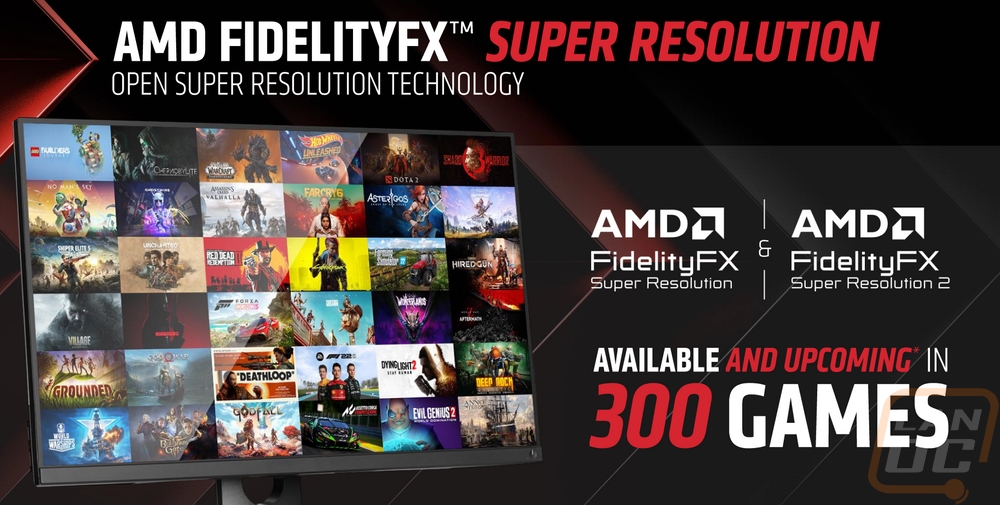
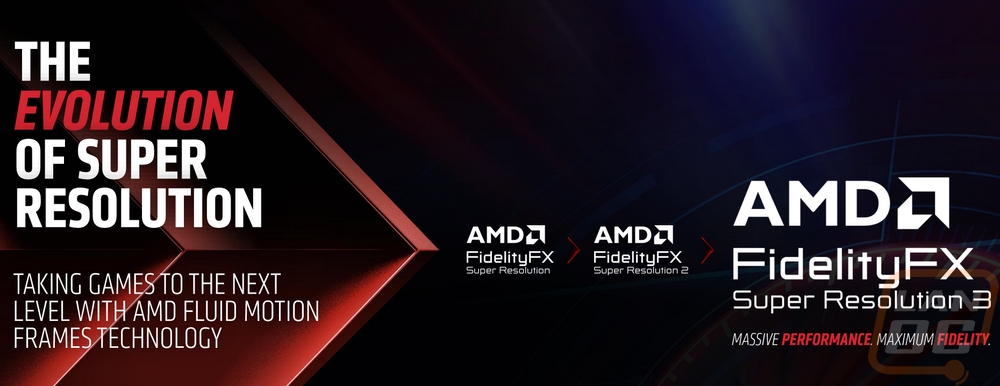
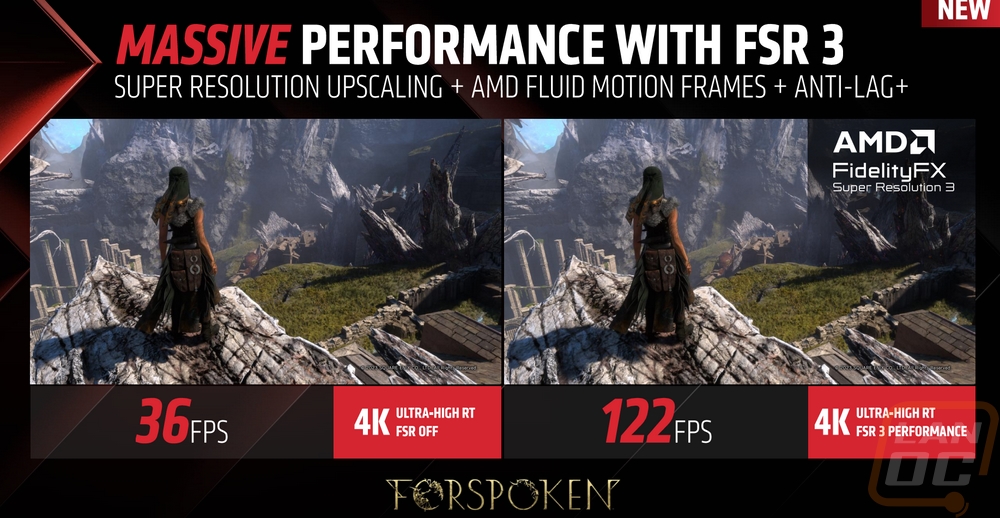
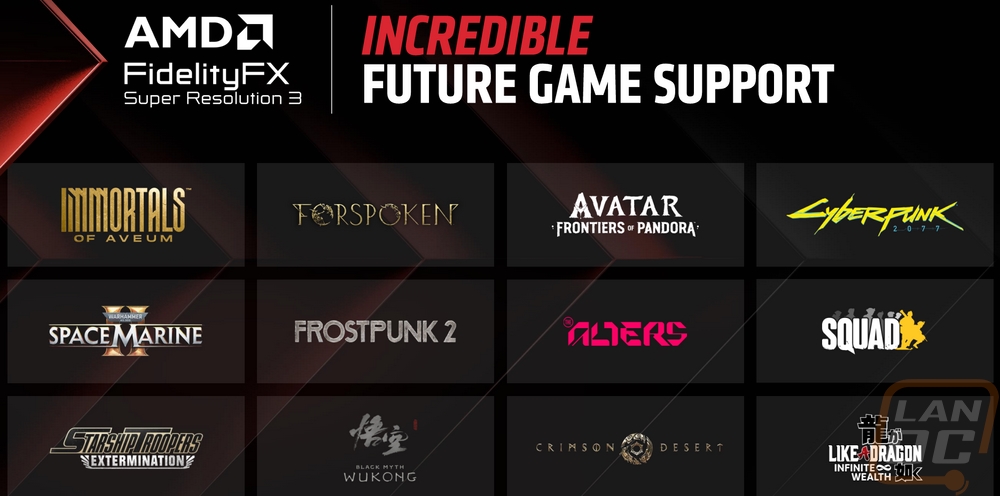
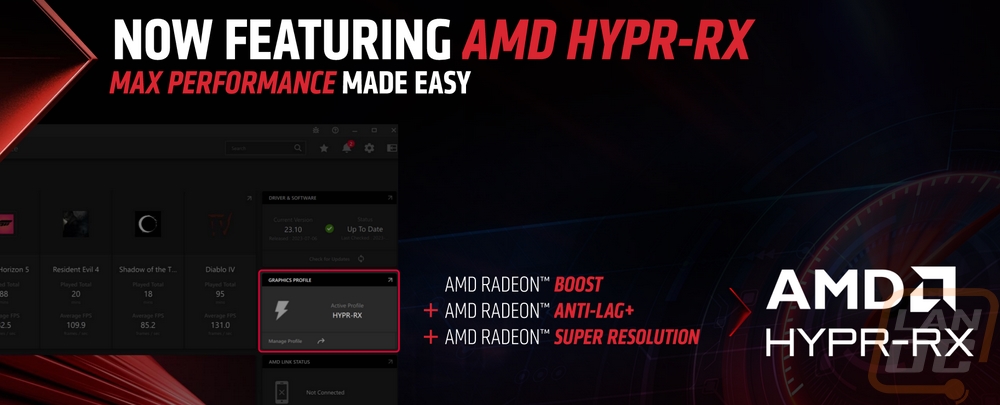
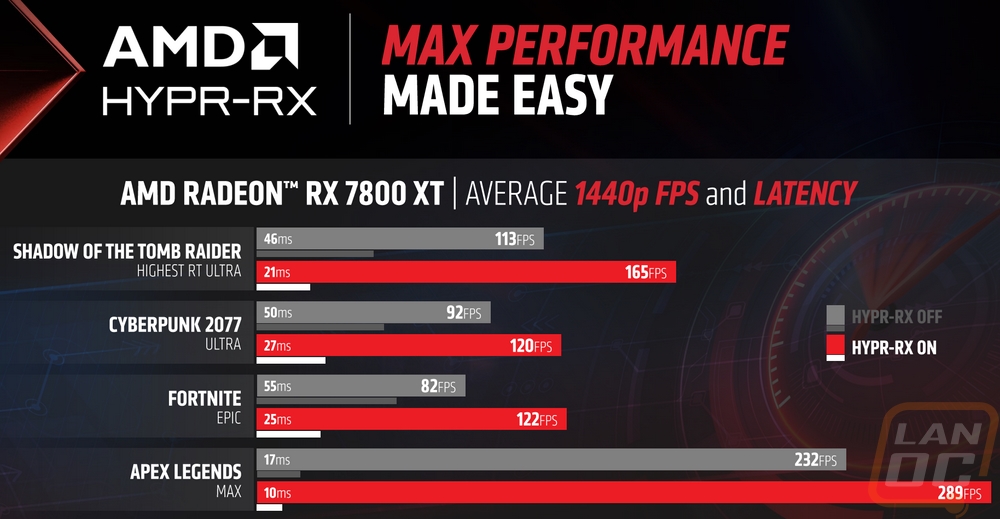
AMD also touched on the streaming capabilities as well on their call. Highlighting AV1 support which is the future of streaming. AV1 can get you higher quality while lowering the bandwidth needs. They also touched on AMDs noise suppression which can help cut out background noise from your microphone.
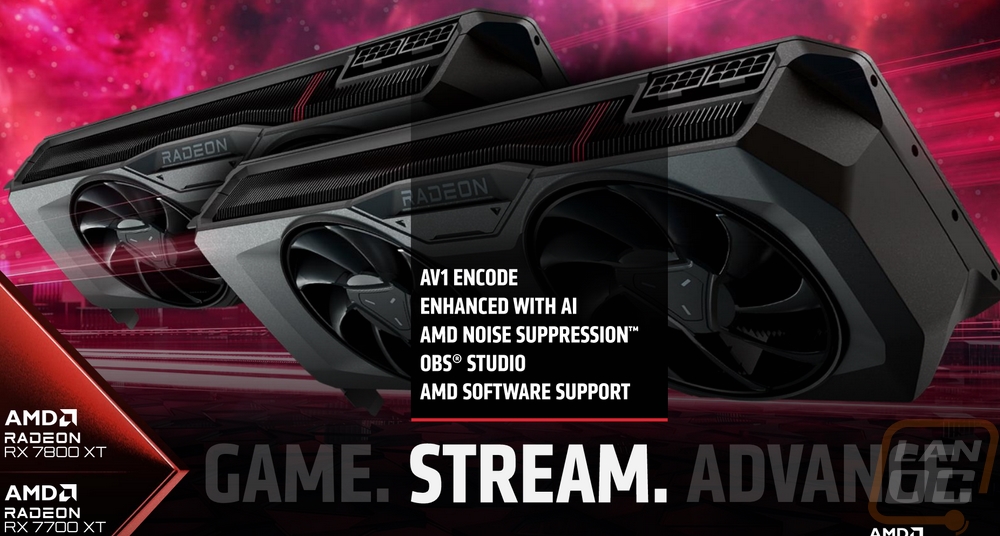
With the RX 7700 XT and RX 7800 XT hitting stores tomorrow September 6th, the cards are also timed to launch the same day as Starfield which utilizes AMDs technology. AMD is also offering a copy of the game to anyone who picks up the 7700 XT or the 7800 XT. This is a great way to add some value to the cards and also make sure everyone has access to a brand new game to check out how your new cards can perform.
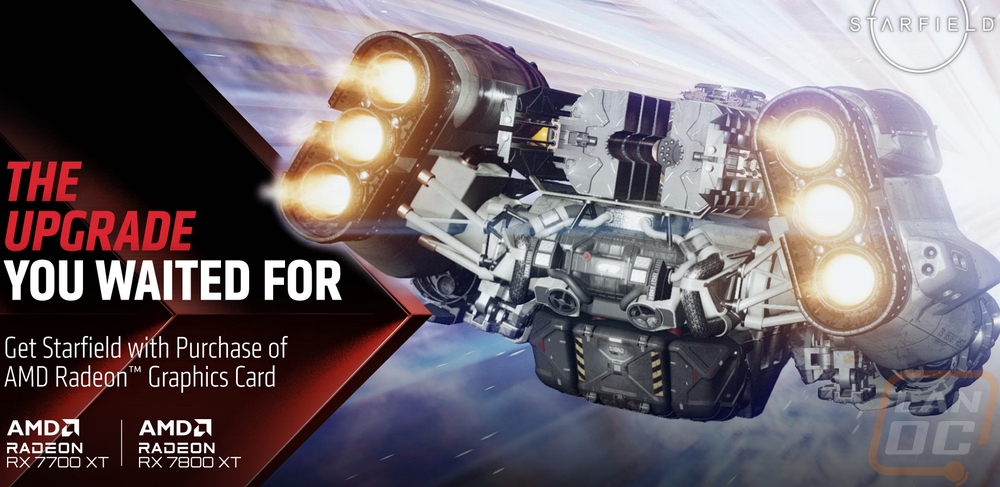
|
|
Game Clock |
Boost Clock |
|
Sapphire RX 7700 XT Pulse |
2171 MHz |
2544 MHz |
|
XFX QICK 319 RX 7700 XT Black |
2276 MHz |
2599 MHz |
|
Sapphire RX 7700 XT PURE |
2226 MHz |
2584 MHz |
Before getting into testing I did also run GPUz to double-check that our clock speeds matched up with the specifications. Because this is the third 7700 XT I am checking out I have also broken down the clock speeds in the table above just to make it easier to see. The Pulse had the stock 7700 XT clocks but the XFX and the RX 7700 XT PURE are both overlocked both on their game clock speeds and for the boost clock. Sapphire still had their Nitro+ which is their flagship, the PURE sits in between and you can see that here with both of its clock speeds sitting a little behind the XFX card. GPUz does confirm what the specifications list For the driver I tested with the Adrenalin 23.20.01.05 driver that AMD provided press ahead of the launch. GPUz also documents our BIOS revision as well for future reference.

|
Sapphire RX 7700 XT PURE Specifications |
|
|
SKU |
11335.03-20G |
|
GPU |
AMD Radeon™ RX 7700 XT Graphics Card 5nm GPU AMD RDNA™ 3 Architecture |
|
Stream Processors |
3456 |
|
Compute Units |
54 CU (with RT+AI Accelerators) |
|
Infinity Cache |
48MB |
|
Ray Accelerators |
54 |
|
Memory Size/Bus |
12GB/192 bit GDDR6 |
|
Displays |
Maximum 4 Displays |
|
Resolution |
HDMI™: 7680×4320 DisplayPort 2.1: 7680×4320 |
|
Interface |
PCI-Express 4.0 x16 |
|
Output |
2x HDMI 2x DisplayPort |
|
BIOS Support |
UEFI |
|
Game Index |
1440P |
|
Sapphire Features |
Premium Digital Power Design Ultra High Performance Conductive Polymer Aluminum Capacitors Fuse Protection Tri-X Cooling Technology High TG Copper PCB Optimized Composite Heatpipe Intelligent Fan Control Precision Fan Control Metal Backplate Red LED SAPPHIRE Logo Two-Ball Bearing Fans Angular Velocity Fan Blade TriXX Supported TriXX Boost |
|
Accessories Bundled |
Graphics Card Supporter |
|
AMD Features |
AMD RDNA™ 3 Architecture 54 AMD RDNA™ 3 Compute Units 48MB AMD Infinity Cache™ Technology DisplayPort™ 2.1 Support AMD Radiance Display™ Engine 12GB GDDR6 on 192-bit Memory Bus PCI® Express 4.0 ready AMD FidelityFX™ Super Resolution technology* Microsoft® DirectX® 12 Ultimate Support Microsoft® DirectStorage Support Vulkan® Optimized AMD Smart Technologies AMD Software: Adrenalin Edition™ AMD Noise Suppression AMD Privacy View AMD Radeon™ Super Resolution technology AMD Link AMD FreeSync™ Technology |
|
Cooling |
3 Fans |
|
Form Factor |
2.5 slot, ATX Dimension: 320(L)X 128.75(W)X 52.57 (H)mm |
|
Power Consumption |
240W Total Board Power |
|
OS |
Linux®, Windows® 10, and Windows 11. 64-bit operating system required |
|
System Requirement |
Minimum 700 Watt Power Supply 2 x 8-pin Power Connector. PCI Express® based PC is required with one X16 lane graphics slot available on the motherboard. Minimum 8GB of system memory. 16GB recommended. |
|
Warranty |
2 Years |
Packaging
The packaging for the Sapphire RX 7700 XT PURE has the same sized box as the RX 7700 XT pulse but the outer packaging is completely different. Where the Pulse had a black stripe across the top, a purple background, and the pulse zig-zag across it. The RX 7700 XT PURE has a white background and has circles and dots on it for its design. It does incorporate that same purple color though. Then along the bottom, it has the standard AMD wrap around which has the red box on the left with the 12GB VRAM, they list some of the AMD tech, and then in the right the big red box has the model name. Sapphire has their logo up in the top right corner and again but smaller above the PURE logo. Then because this is an overclocked card it has a Sapphire small overclock sticker to indicate that. The back of the box is a lot like what we saw on the Pulse which is to say other than the continuation of AMDs wrap around which lists more RDNA 3 features there isn’t too much going on back here. It has a white background and a few smaller circles similar to the front. There is also a basic specification listing that just has the display connections and your system requirements. I would love to see the card dimensions here and pictures of the card on the front or back would be really helpful for anyone shopping in a retail store.


Once you take the outer cover off of the RX 7700 XT PURE you have a brown box which gives everything its structure. When you open the brown box you have a layer of foam on top and then the documentation. Under that is a thick foam layer, this has a cutout to fit perfectly around the RX 7700 XT PURE which sits in there in a static protective bag. The card also comes with plastic covering most of the card for additional protection. There is also a slot in the foam for accessories as well to keep them from moving around.



For documentation, the RX 7700 XT PURE comes with the same generic quick installation guide that we saw with the Pulse and every other Sapphire card. The RX 7700 XT PURE also had an installation guide for the support bracket that is included. The bracket has the Sapphire branding on it and is bright white to match the card. It comes with the screws and has its support pad already pre-installed. That pad is adjustable most of the length of the support with that long slot across it.


Card Layout and Photos
If we ignore the bright white finish and the third fan the RX 7700 XT PURE is very similar to the design of the RX 7700 XT Pulse. It has the same hockey stick like line accents between the fans and sticking out toward the ends. But those accents look a lot better in grey on the white than they do with red on the black. It makes me think that on the Pulse grey would have looked good on it as well. The fan shroud is all plastic and half is flat with the angled top and bottom edges on the left, again just like the Pulse. They even have the same fan design only these are bright white to match the rest of the RX 7700 XT PURE. But I have to admit that there is something about the all-white card that just puts it a step above.


To fit the third fan into the mix, the RX 7700 XT PURE is a longer card than the Pulse. It is 320 mm long which is 15mm shorter than the XFX QICK and 40 mm longer than the RX 7700 XT Pulse. It is 128.75 mm tall, the same as the RX 7700 XT Pulse, and just a hair shorter than the QICK. It is a 2.5-slot thick card measuring in at 52.57 mm, which makes it more of a 2.6-slot card really, and is the same thickness as the Pulse and less than a mm thinner than the QICK.




The triple fan design does have one big distinction from the dual fan RX 7700 XT Pulse, the center fan spins in the opposite direction which you can tell from the twist of the blades. This is a trick that Gigabyte uses as well and it helps with any air that doesn’t blow down into the heatsink. With the middle fan flipped the right side of the left fan has its air going down and to the right while the middle fan on the left side has air going down and to the left and you get less turbulence. The fan design is the same other than that with the dual angled blades which Sapphire calls their angular velocity fan blade. The fans have dual ball bearings and on the outside have a ring around the edge that locks all of the blades in together. They have a sticker in the middle with the Sapphire PURE branding and a circle with a dot similar to what was on the packaging. Through the fans, you can see the aluminum sheet metal heatsink which is in a vertical orientation to push warmed air up towards the top and bottom of the card.




Up on the top edge of the RX 7700 XT PURE, a few things are going on. The fan shroud and the backplate both wrap around to leave room to put a few logos on there. On the end of the card is a grey Radeon logo. Then in the middle, there is a big red piece that is attached to the fan shroud with white printed on it leaving a red Sapphire logo. This is backlit to light this and the entire area up in red. Then of course the top also has the power connections. The RX 7700 XT PURE has two 8-pin PCIe power plugs, just like all of the other RX 7800 XTs and RX 7700 XTs. The benefit of course is that with the older PCIe plug you can use your old power supply if you have one and can avoid having to use an ugly adapter.



Working around the top and bottom edges as well as the end of the card tells us a little more about the cooling setup as well on the RX 7700 XT PURE. The top of the card has both the fan shroud and backplate wrapped around the length of the card with them touching at the start and down at the end. This covers up some of the airflow room but Sapphire has compensated for that with openings on the backplate. The covers section down at the end helps force the air into the blow-through section as well. The end of the RX 7700 XT PURE is mostly covered and bright white but does have a window that gives us a peek through to see the end of the heatsink and the five exposed heatpipes. Then along the bottom, we can see that each section of the heatsink is perfectly formed around each component on the PCB to not leave any surface area. In the center you can see where the heatpipes shift up and also how they contact the heatspreader that sits on top of the GPU and memory. The heatpipes are flattened there for the best contact and the five heatpipes that we saw at the end of the card continue on to the left side of the card as well with three of those wrapping around a second time as well. Then there is the one 6-pin connection to run power up to the fans and for the lighting. Even these wires and the plug are bright white to match the rest of the RX 7700 XT PURE.






The backplate for the RX 7700 XT PURE is again similar to what we saw on the RX 7700 XT Pulse. It is stamped metal and wraps around up at the top to give it more strength. Sapphire has cut out multiple triangle-shaped holes along the top edge for additional airflow at the top of the heatsink. There is also a cutout around the back of the GPU and GPU support bracket and more holes down at the end of the card. Those are the blow-through design once the heatsink gets past the PCB. Sapphire has also hidden a small switch in the middle that turns the lighting up on the top of the card off. The backplate is of course bright white to match the rest of the card and has a few lines printed on it in grey as accents along with the Radeon logo which is also in grey and the Sapphire PURE logo in grey and black. All of that text is upside down to make it readable when installed in most cases.



For display connections, the RX 7700 XT PURE has the same setup that the RX 7700 XT Pulse had. You get two HDMI and two DisplayPort connections. This is unique compared to what you see from almost anyone else, three DisplayPort and one HDMI are the standard these days. Most monitors can support either and having an extra HDMI could be a benefit if you have older monitors or if you are using televisions at all. The PCI bracket has a tinted metal finish and it does have the Sapphire logo stamped into it down at the bottom edge. The RX 7700 XT PURE isn’t designed to push air in this direction at all but above all of the display connections, it does also have some ventilation which consists of angled slots.

I did get a picture of the RX 7700 XT PURE alongside of the RX 7700 XT Pulse and I think that does a great job of showing just how similar the design is while also being completely opposites with the all-white and black with red accents. I included a second picture with the XFX QICK 319 RX 7700 XT Black in there as well and you can see how it is longer and while it has a triple fan configuration it doesn’t have the same size fans as the RX 7700 XT PURE does. I do like that the XFX doesn’t have branding all over it though, the RX 7700 XT PURE has a Sapphire logo visible from any angle you look at it including three on the front.


The red accent at the top of the RX 7700 XT PURE is backlit as well. It lights up the logo and really the entire center of the card in a Radeon red. This isn’t RGB and you can’t do anything fancy with the lighting other than using the switch on the back to turn it on or off. I’m not a big fan of backlit branding, it can make your PC start to feel like Times Square but I have to admit that I do like the glow that this lighting gave the rest of the card. It would be nice if it was in more than just that one spot though and even just white lighting would be nice or RGB to be able to pick a color that matches your build.



Test Rig and Procedures
CPU: Intel Core-i9 13900K – Live Pricing
PL1=PL2: 253, τ: 56 / 307A
Motherboard: Asus Z790 Extreme – Live Pricing
Cooling: Corsair H100i Elite LCD Display - Live Pricing
Noctua NT-H1 Thermal Paste - Live Pricing
Memory: Crucial 32GB Kit (2 x 16GB) DDR5-5600 UDIMM– Live Pricing
Storage: Sabrent Rocket Q4 2TB – Live Pricing
Power Supply: be quiet! Dark Power Pro 13 1600W- Live Pricing
Case: Primochill Wetbench - Live Pricing
OS: Windows 11 Pro 64-bit - Live Pricing
|
Our Testing Procedures |
|
|
3DMark |
All 3DMark-based tests are done using the most recent version. We test using all three versions of Fire Strike, Both Time Spy and Time Spy Extreme, and Speed Way. Tests to look at ray tracing performance are done with Port Royal when supported and for Nvidia cards that support DLSS, the DLSS subtest is also done at 1440p with the performance setting and DLSS 2.0 as well as a look at DLSS 1, 2, and 3 at 4K. |
|
Unigine Superposition |
1080p Extreme and 4k Optimized benchmarks along with the VR Future test are done. The VR test is done at the Oculus resolution |
|
VRMark |
Only the Blue room test is run |
|
CS:GO |
This test is done using the workshop map called CS:GO Benchmark. You can find more information at this link. https://www.gamingpcbuilder.com/how-to-install-csgo-fps-benchmark-map/ I test at 1080p, 1440p, and 4K resolutions. All auto settings are turned off and detail is set to their highest settings. shadow quality high, model texture detail high, shader detail very high, AA set to 16x, uber shaders enabled |
|
Ghost Recon Breakpoint |
Built-in benchmark tested at 1080p, 1440p, and 4k with the Ultra and Medium detail settings |
|
Watch Dogs: Legion |
Built-in benchmark testing at ultra and high details. Tested at 1080p, 1440p, and 4k. I also do RTX and DLSS testing on Nvidia cards at 4K using the Ultra detail settings as a base as well. |
|
Borderlands 3 |
Built-in benchmark testing with the ultra detail setting and medium detail setting, done at full screen with default settings at 1080p, 1440p, and 4k on DX11 |
|
Metro Exodus |
Using built-in benchmark, testing at ultra and normal details at 1080p, 1440p, and 4k. I also do RTX and DLSS testing at 4K with the ultra-detail base settings for Nvidia cards as well. |
|
World War Z Aftermath |
Built-in benchmark in DX11 testing both the Ultra detail and Medium detail levels at 1080p, 1440p, and 4K resolutions |
|
The Division 2 |
Built-in benchmark at Ultra detail with V-Sync turned off at 1080p, 1440p, and 4k resolutions. |
|
Total War: Three Kingdoms |
Built-in benchmark using the Battle Benchmark setting. Tested at 1080p, 1440p, and 4k at both high and ultra detail settings |
|
Far Cry 6 |
Built-in benchmark tested at 1080p, 1440p, and 4k with the Ultra and Medium detail settings |
|
V-Ray 5 |
V-Ray 5 benchmark us run with CUDA and RTX settings on cards that support it |
|
Boundary Benchmark |
Testing different DLSS detail levels on cards that support it. All testing is done at 4k with RTX on |
|
Bright Memory Infinite RTX Benchmark |
Benchmark all of the different RTX detail levels. Resolution at 4k and DLSS on balanced for each test |
|
Passmark Performance Test 10.2 |
Test using the GPU Compute Score inside of PassMark's Performance Test 10.2 |
|
Blender |
Using the standard Blender Benchmark I run the test using the Blender 3.4 setting which tests using the Monster, Junkshop, and Classroom tests. |
|
OctaneBench 2020.1 |
OctaneBench is designed to test rendering in OctaneRender. RTX and non-RTX are both ran. This is a CUDA-only test so only Nvidia cards are tested |
|
Power Testing |
Using a PCat v2 to monitor power between the PCIe slot and the card as well as power through the power cables I test the peak power when running ADIA64, 3DMark Speed Way, 3DMark Time Spy Extreme, FarCry 6 at 4k and Ultra Detail, Watch Dogs Legion at 4K and Ultra detail, and Blender 3.4.0. The results are then averaged as well as the highest result. |
|
Noise Testing |
Our Noise testing is done using a decibel meter 18 inches away from the video card on the bottom/fan side of the card. We test at 50% and 100% fan speeds as well as a third test while under load using AIDA64's stress test. This is done using a Protmex PT02 Sound Meter that is rated IEC651 type 2 and ANSI S1.4 type 2. Tests are done set weighted to A and set to a slow response using the max function. The ambient noise level in the testing area is 33.3 decibels. |
|
Temperature Testing |
Using AIDA64, the GPU stress test is run for 30 minutes or until the result has leveled off. The test is run twice, once with the stock fan profile and a second time with 100% fan speed. During this, I also document the 100% fan speed RPM and document the delta between the fan profile and 100% fan speed as well as get thermal images. |
Synthetic Benchmarks
As always I like to start my testing with a few synthetic benchmarks. 3DMark especially is one of my favorites because it is very optimized in both Nvidia and AMD drivers. It's nice to not have to worry about it being favored too much either way and the repeatability of the results makes it a nice chance to compare from card to card, especially when comparing with the same GPU. With the two other reviews, we already have a good idea of where the 7700 XT lands. What I’m most interested in this time around is seeing how the RX 7700 XT PURE compares to the RX 7700 XT Pulse and the XFX QICK 319 RX 7700 XT Black. The RX 7700 XT Pulse has AMDs stock clocks and the XFX and the RX 7700 XT PURE both are overclocked with the XFX having an edge with 15 MHz more on the boost clock and 50 MHz on the game clock. But we saw last time that a lot of our tests the overclock didn’t make much of a difference, I’m curious if that will be the same with the PURE this time around.
The first round of tests were done in the older Fire Strike benchmark which is a DX11 test. There are three detail levels, performance, extreme, and ultra. The RX 7700 XT PURE scored a 41539 in the base Fire Strike benchmark putting it behind both the Pulse and the QICK. In Fire Strike Extreme it moved back up in between the two cards then with Fire Strike Ultra it was out in front of them both.



The next two were both based on the Time Spy benchmark. One is the standard test and then there is the extreme detail level. Time Spy is a DX12 benchmark and is a better representation of the current generation of games. The RX 7700 XT PURE scored a 16869 for the base Time Spy benchmark putting it ahead of the Pulse but behind the QICK, right where you would expect it to be. In Time Spy Extreme, however, it was out in front of both cards just slightly. That wasn’t enough to get any closer to the RTX 4070 but like with the other 7700 XT that put it in front of the RTX 3070 Ti and way out in front of the 4060 Ti.


For ray tracing performance, I ran both the 3DMark Port Royal test which is ray tracing focused as well as the new 3DMark Speed Way test which tests all future-looking features including ray tracing. In Speed Way, the RX 7700 XT PURE is right in the middle of the two RX 7700 XTs once again. All three cards were down below the RTX 4060 Ti here. In Port Royal, the RX 7700 XT PURE is in front of the other RX 7700 XT by 14 points. When we compare that with Time Spy performance you can see that AMD is still playing catch up with ray tracing.


I did also run 3Dmark’s FSR 2 tests across all four of the detail levels. This wasn’t to compare card to card but to check out what kind of performance improvements you can see when using AMDs AI-based processing to lighten the load. The RX 7700 XT PURE went from 22.04 FPS without FSR 2 up to 43.28 FPS when using the highest detail setting. Balanced took it up to 51.57 FPS which is good but with the performance setting it surpassed 60 FPS for 64.81 FPS. Then with Ultra-Performance, it was up to 101.47 FPS.

The last test was using the Unigine-based Superposition benchmark and I tested at 1080p with the extreme detail setting as well as the 4K optimized setting. In the extreme detail setting the RX 7700 XT PURE topped the three RX 7700 XT in both tests. It wasn’t enough to catch up to the RTX 370 Ti here though but was still in front of the RTX 4060 Ti 8GB.

VR Benchmarks
As for Virtual Reality, I love it but it is more demanding than traditional gaming. This is partially because of the resolutions needed to render for two eyes and because they render more than what is immediately visible. But also because of post effects to get the proper “fisheye” effect for it to look proper in your eyes with the HMD. You also have to have much higher expectations for frame rates in VR, skipping frames or lower FPS can cause motion sickness in VR. Because of that, I ran a few tests.
My first test was again in Superposition. This time I tested the VR Future test using the Oculus resolution. I have also included the average frame rate as well which is important for the cards at the top of the chart because for some reason Superposition is capped at 10,000 for its scores and that doesn’t show the performance gap in those cards at the top. The RX 7700 XT PURE outperformed the other two RX 7700 XTs but the bigger story is that was enough for it to just barely edge past the RTX 4070 Founders Edition that was sitting just above them.

My second round of VR testing was in VRMark which has three tests that are similar to the VR tests in Superposition. I only focused on just the most demanding test called Blue Room which is looking more at future VR performance. The RX 7700 XT PURE is ahead of the Pulse and RTX 3070 Ti here but the QICK is out in front of the PURE here by 66 points.

In-Game Benchmarks
Now we finally get into the in game performance and that is the main reason people pick up a new video card. To test things out I ran through our new benchmark suite that tests 10 games at three different resolutions (1080p, 1440p, and 4k). Most of the games tested have been run at the highest detail setting and a mid-range detail setting to get a look at how turning things up hurts performance and to give an idea of if turning detail down from max will be beneficial for frame rates. In total, each video card is tested 48 times and that makes for a huge mess of results when you put them all together. To help with that I like to start with these overall playability graphs that take all of the results and give an easier-to-read result. I have one for each of the three resolutions and each is broken up into four FPS ranges. Under 30 FPS is considered unplayable, over 30 is playable but not ideal, over 60 is the sweet spot, and then over 120 FPS is for high refresh rate monitors.
So how did the RX 7700 XT PURE do? At 4k 10 out of the 16 results were up over 60 FPS and 1 was up over 120 FPS as well. The other 6 results were all in the 30-59 FPS range where they are playable but not smooth. Overall 4k is possible but not ideal. The 7700 XT is targeted at 1440p gaming and you can see it with the RX 7700 XT PURE having every one of our results averaging up over 60 FPS. 11 results were even higher at 120 FPS and one of those was over 240 FPS. High refresh gaming is possible at 1440p. Then at 1080p, everything but one result was up over 120 FPS with three of those up over 240 FPS as well and that is with a lot of those games being CPU limited at that resolution.



Of course, I have all of the actual in game results as well for anyone who wants to sort through the wall of graphs below. I also have averaged out the numbers for all of the cards around the RX 7700 XT PURE at all three resolutions that we tested at. There weren’t any big surprises when it comes to where the RX 7700 XT fits in the market, like with our other reviews the RX 7700 XT PURE was surprisingly close to the RTX 4070 and ahead of the RTX 3070 Ti. The RTX 4060 Ti 8GB is down farther with it averaging 115.3 FPS at 1440p to the RX 7700 XT PURE at 138.0. As for how the RX 7700 XT PURE compared to the Qick and Pulse they are all close together. At 1440p the QICK is ahead by .2 FPS but at 4K the RX 7700 XT PURE is ahead by .3 FPS or in other words not far enough apart to matter.
|
|
1080p |
1440p |
4K |
|
XFX MERC 319 RX 6800 XT |
197.1 |
162.3 |
92.4 |
|
XFX Merc 319 RX 7800 XT Black |
194.0 |
161.0 |
93.3 |
|
Radeon RX 7800 XT |
190.7 |
156.3 |
89.3 |
|
Nvidia RTX 4070 FE |
190.6 |
147.6 |
83.5 |
|
XFX QICK 319 RX 7700 XT Black |
179.9 |
138.2 |
75.2 |
|
Sapphire RX 7700 XT PURE |
180.9 |
138.0 |
75.5 |
|
Sapphire RX 7700 XT Pulse |
178.1 |
137.5 |
74.7 |
|
Nvidia RTX 3070 Ti FE |
165.8 |
125.7 |
72.9 |
|
Sapphire Nitro+ RX 6750 XT |
165.2 |
119.4 |
64.5 |
|
Nvidia RTX 3070 FE |
160.9 |
118.8 |
67.2 |
|
Nvidia RTX 4060 Ti 8GB FE |
160.1 |
115.3 |
62.0 |
|
Zotac RTX 4060 Twin Edge OC |
135.7 |
94.5 |
50.1 |
















Compute Benchmarks
Now some people don’t need a video card for gaming, they need the processing power for rendering or 2D/3D production, or in some cases people who game also do work on the side. So it is also important to check out the compute performance on all of the video cards that come in. That includes doing a few different tests. My first test was a simple GPU Compute benchmark using PassMark's Performance Test 10 and the RX 7700 XT PURE scored a 15951 which was 17 points higher than the QICK and edged the card even closer to the stock clocked RX 7800 XT. All of the 7700 XT were ahead of the 6800 XT as well as the 4060 Ti 8GB.

Blender is always my favorite compute benchmark because the open-source 3D rendering software is very popular and it isn’t a synthetic benchmark. With the latest version of Blender, they redid the benchmark so we now have a new test that runs three different renderings and gives each a score. I have all three stacked together so we can see the overall performance. The RX 7700 XT PURE, like all of the AMD cards, struggled with Blender performance compared to the Nvidia cards. The RX 7700 XT PURE did end up ahead of the other 7700 XT in the 3.5 benchmark but was at the bottom of the three on Blender 3.6.


Cooling Noise and Power
For my last few tests, rather than focusing on in game performance, I like to check out other aspects of video card performance. These are also the most important ways to differentiate the performance between cards that have the same GPU. To start things off I took a look at power usage.
For this, our new test setup utilizes the Nvidia-designed PCat v2 along with cables to handle both traditional 6 or 8-pin connections as well as the new 12VHPWR. The PCat also utilizes a PCIe adapter to measure any power going to the card through the PCIe slot so we can measure the video card wattage exclusively, not the entire system as we have done in the past. I test with a mix of applications to get both in game, synthetic benchmarks, and other workloads like Blender and AIDA64. Then everything is averaged together for our result. I also have the individual results for this specific card and I document the peak wattage result as well which is almost always Time Spy Extreme. The RX 7700 XT PURE averaged 260 watts across all of the tests and peaked at 303 watts. This came in right in the middle of the pack between the Pulse and the QICK with the QICK 13 watts higher on the average and 13 watts higher on the peak as well. The wattage range between the three cards is the most surprising thing really with 33 watts between the top and bottom cards.


With having exact peak wattage numbers when running Time Spy Extreme I was also able to put together a graph showing the total score for each watt that a card draws which gives us an interesting look at overall power efficiency in the popular and demanding benchmark. Landing in the middle for power draw between the three 7700 XT helped the RX 7700 XT PURE a lot in the efficiency numbers. The stock-clocked Pulse is still more efficient but the PURE did do better than the QICK. That at least kept it above the reference RX 7600 but the Nvidia cards from this generation are still noticeably better on efficiency with the 4060 Ti for example 5.86 points per watt more efficient.

My next round of tests were looking at noise levels. These are especially important to me because I can’t stand to listen to my PC whirling. Especially when I’m not in game and other applications are using the GPU. For my testing, though I first tested with the fan cranked up to 100% to get an idea of how loud it can get, then again at 50% to get an idea of its range. The RX 7700 XT PURE came in the middle of the pack at 50% fan speed, similar to the Pulse which isn’t a surprise given that they have the same fans just the PURE has one more. What is more impressive though is how at 100% fan speed the RX 7700 XT PURE and the Pulse both dropped down the chart when the XFX card went the other direction.



I also take a look at noise performance while under load. For that when running AIDA64’s stress test I wait until the temperature of the card has leveled off and then measure how loud things are when the card is at its worst-case scenario with the stock fan profile. In my opinion, this is also the most important noise result as well, how loud the card can be is one thing, how loud it is when you are actually using it is a lot more important. The RX 7700 XT PURE is down in the bottom 1/3 of the chart at 36.9 dB. This was 4.3 dB lower than the RX 7700 XT Pulse and 6.8 dB lower than the XFX QICK 7700 XT making the RX 7700 XT PURE the quietest of the three cards tested while in game and it isn’t even close. When under load the cards fans were running at a max of 39% so there is still plenty of headroom left as well.


To finish up my testing I of course had to check out the cooling performance. To do this I ran two different tests. I used AIDA64’s Stress Test run for a half-hour each to warm things up. Then I documented what temperature the GPU leveled out at with the stock fan profile and then again with the fans cranked up to 100%. With the stock profile, the RX 7700 XT PURE is down at the bottom of the chart with an impressive 52c. For comparison, the Pulse was 55c and the XFX card was 56c in this same test. The RX 7700 XT PURE had its GPU hotspot at 85c with the stock fan profile, 6c lower than the Pulse, and 4c lower than the XFX QICK. At 100% fan speed the RX 7700 XT PURE is still down near the bottom of the chart, dropping down to 44c here which is just 2c lower than the stock-clocked Pulse but 8c lower than the QICK. Its GPU hotspot was 75c at 100% fan speed, 2c lower than the Pulse, and 9c lower than the QICK.




While running the stock fan profile testing I also took the time to get a few thermal images so we could see what is going on. The fan side of the RX 7700 XT PURE is nearly room temperature down at the end with the blow-through section. Even to the left of that though the hottest spot I could find was just 34c and that was just a small spot behind the far left fan. Up on the top edge however it is a different story, the fans are pushing all of the air up this direction and the PCB is exposed here as well which is the hot stripe you see on the top edge. The cooler is running around 40c but the PCB peaks out at 51.5c over on the left closer to the GPU. The same goes for the back of the card with the exposed PCB directly behind the GPU, that spot is the hottest spot on the card at 56.4c. The rest of the metal backplate has soaked up some heat and you can see how the farther away from the GPU you get the cooler it is. Overall though there wasn’t anything of concern on the thermals.



Overall and Final Verdict
It’s interesting just how much a few changes can make a big difference when it comes to how different the Sapphire RX 7700 XT Pulse and the Sapphire RX 7700 XT PURE. They have nearly the same shroud and backplate design, even the line drawings are the same. But with the RX 7700 XT PURE being bright white and all of those accents changing from red to grey I like the RX 7700 XT PURE’s styling a lot more than the Pulse. It is also exciting to see Sapphire finally fully embracing the white PC build, a lot of the “white edition” models from other companies are limited runs and ask for a premium, I’m not expecting that to be the case with the RX 7700 XT PURE. The only downside aesthetically for me was the red up on top of the card as well as the lighting being red. White or RGB would better fit the white card, but the way the lighting lights up and in some areas glows through the white card looks great. Having lighting that covered the entire top would look better, however, not just a hotspot in the middle.
The RX 7700 XT PURE didn’t have as large of an overclock as we saw with the XFX QICK 7700 XT Black but with its mid-range overclock it held its own in our testing, coming out on top compared to the other RX 7700XTs more than it should. That means of course that the RX 7700 XT PURE outperformed the 4060 Ti 8GB in nearly every test by a big margin and even outperformed cards like the RTX 3070 Ti as well. This translates to great 1440p performance and at least some capabilities at 4K. What impressed me more than anything was how well the RX 7700 XT PURE performed in our cooling tests, its mid-range overclock combined with a capable cooler had it running cooler than almost any other card tested. Its noise results were great as well, especially in our under-load test that replicates what you can expect in heavy game use. Like with the other 7700 XT the RX 7700 XT PURE did struggle in our Blender benchmarks and still has room to improve when it comes to ray tracing performance compared with Nvidia. The RX 7700 XT PURE uses standard PCIe power connections, so you can avoid having to use an adapter or having to upgrade your power supply which can save some money if you already have a PSU.
For pricing, Sapphire has the RX 7700 XT PURE priced at $469. The base MSRP of the RX 7700 XT is $449 and the premium for an overclocked card with a larger cooler isn’t too bad at just $20. The big problem however is just how close the RX 7700 XT and the RX 7800 XT are pricing-wise with the 7800 XT’s base MSRP at $499. This makes it hard to justify the 7700 XT and even harder as the prices get closer to the 7800 XT MSRP. Hopefully, this will be adjusted in the future, especially with the RX 7700 XT PURE because it is an amazing card. The RX 7700 XT PURE is the sweet spot 7700 XT with the looks, cooling and noise performance, and is overclocked.


Live Pricing: HERE




